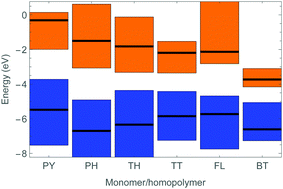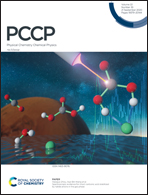Tight binding models accurately predict band structures for copolymer semiconductors
Abstract
Conjugated polymers possess a wide range of desirable properties including accessible band gaps, plasticity, tunability, mechanical flexibility and synthetic versatility, making them attractive for use as active materials in organic photovoltaics (OPVs). In particular, push–pull copolymers, consisting of alternating electron-rich and electron-deficient moieties, offer broad optical absorption, tunable band gaps, and increased charge transfer between monomer units. However, the large number of possible monomer combinations to explore means screening OPV copolymers by first-principles quantum calculations is computationally intensive. If copolymer band structures could be rapidly computed from homopolymer data, potential materials could be screened more efficiently. In this work, we construct tight binding models of copolymer band structures with parameters determined by density functional theory (DFT) calculations on homopolymers. We use these models to predict copolymer valence and conduction bands, which compare well to direct DFT calculations of copolymer band structures.



 Please wait while we load your content...
Please wait while we load your content...